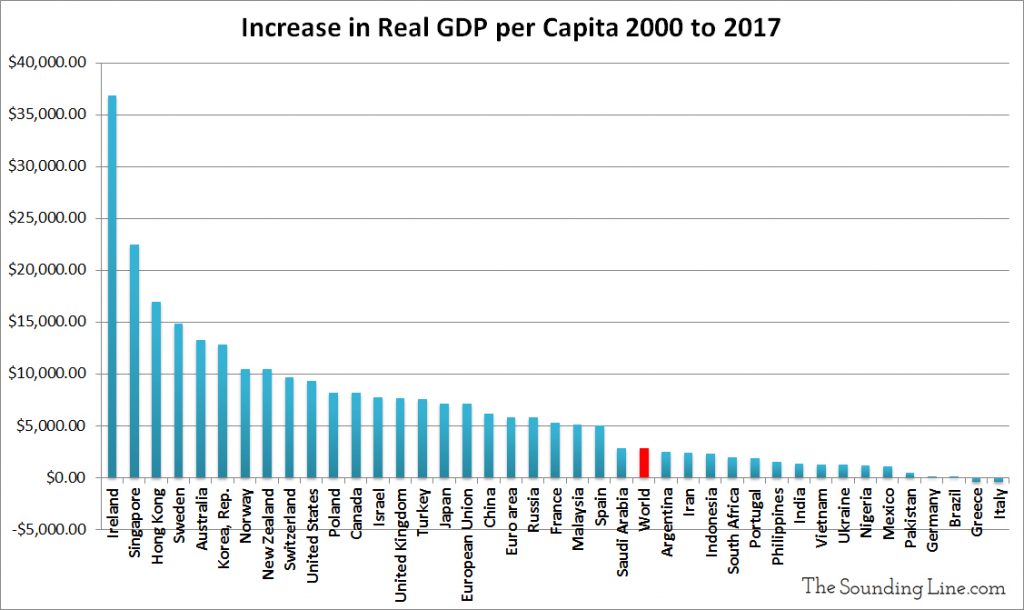Submitted by Taps Coogan on the 19th of February 2019 to The Sounding Line.
Enjoy The Sounding Line? Click here to subscribe for free.
In the modern world, economic growth is king. Not only is economic growth necessary to develop high standards of living, afford imports from other countries, pay for defense spending, and fund investment in new technologies and infrastructure, it is increasingly necessary to service mounting debt and entitlement burdens weighing on virtually every economy.
There are many ways to measure economic growth. In the past, we have looked at the inflation adjusted GDP growth in all major countries since 2000 in their local currencies. Today, we analyze the per capita GDP growth of the world’s major economies in US dollars, adjusted for inflation and changes in population from 2000 to 2017, the latest date for which complete data is available.
The following chart shows GDP growth per capita in every major economy in the 21st century, adjusted for inflation and changes in population, in 2017 dollars.

Among the selected economies, Ireland has witnessed by far the largest real per capita GDP growth in the 21st century, over $36,000, likely thanks to being one of the few countries in the EU with a highly competitive tax regime. Ireland is followed by Singapore and Hong Kong. Norway, Sweden, South Korea (Korea, Rep.), New Zealand, Switzerland, and the US all rank relatively high.
The world average is a modest $2,767 increase per capita since 2000. Despite all the press about the emerging global middle class, world economic growth has just barely outgrown the population, once inflation is accounted for. On average, real global per capita GDP has grown by $162 a year since 2000, roughly 2% per year.
Interestingly, despite China’s famously fast growing economy, it has added less real GDP per capita in the 21st century than the US, the EU, or Japan, though it did outperform the Eurozone. It is easy to forget that while China’s economy is growing very fast and has now become very large, its population is immense and, per capita, its economy is still more than six times smaller than the US. While many less developed economies are growing much faster than the US, Japan, or Europe, those growth rates are occurring in much smaller economies. In the extreme, if one goes from making $1 a year to $2, the growth is an astounding 100%, but it’s still just $1 dollar more.
At the other end of the spectrum, Germany has enjoyed a paltry $9.83 of inflation adjusted, population adjusted, per capita GDP growth so far in the 21st century. While Germany remains one of the wealthiest economies in Europe, its real growth has been barely enough to keep up with its population. The same is true of Brazil ($2.37). Meanwhile, Greece’s economy has shrunk $413.93 per capita and Italy has shrunk $427.97 per capita. As such, the Eurozone contains both the worst (Italy) and best (Ireland) performing economies in this metric.
One theme that has maintained true throughout our various comparisons of economic growth is just how weak the economies of Southern Europe are. Time and time again, Italy, Greece, Portugal, and Spain turn up among the worst performing economies in the world in various growth metrics (here, here, here, here, here).
P.S. If you would like to be updated via email when we post a new article, please click here. It’s free and we won’t send any promotional materials.
Would you like to be notified when we publish a new article on The Sounding Line? Click here to subscribe for free.

